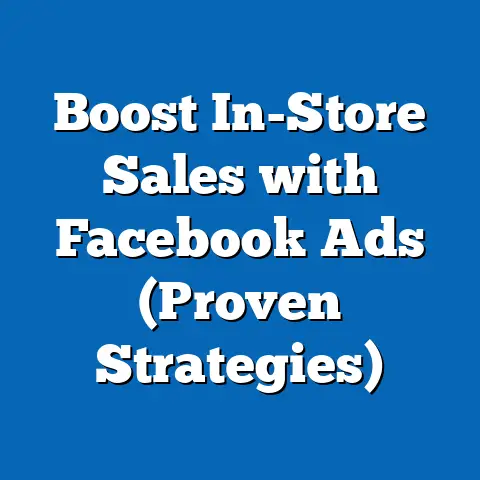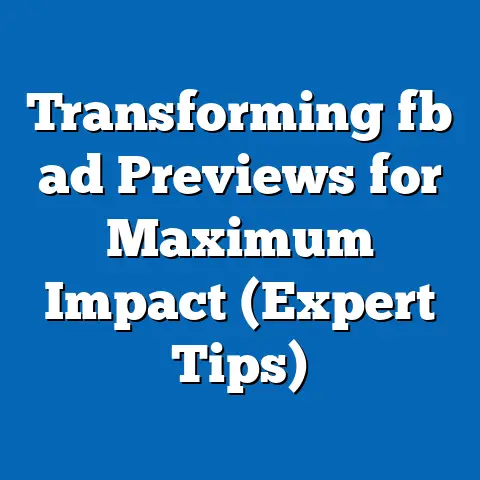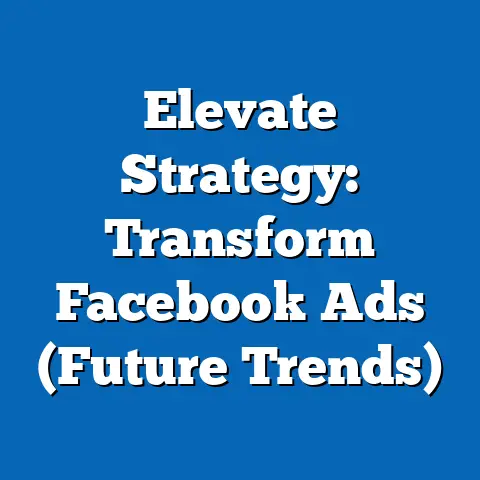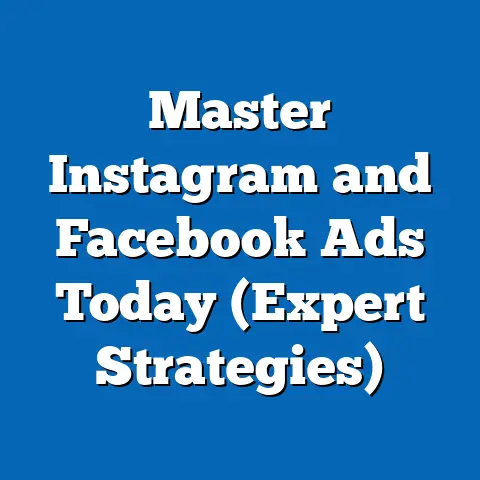Master Facebook Ads Management (Pro Strategies Revealed)
This comprehensive analysis will explore key metrics, demographic trends, and technological advancements shaping Facebook Ads. It will also present actionable insights for advertisers, supported by statistical models and scenario planning. Our goal is to equip marketers with the tools to navigate this dynamic landscape effectively.
Section 1: Current Data on Facebook Ads Performance
1.1 Key Metrics and Benchmarks
As of 2023, Facebook Ads remain a cornerstone of digital marketing, with global ad revenue reaching approximately $131 billion in 2022, a 12% increase from the previous year (eMarketer, 2023). The average cost-per-click (CPC) across industries stands at $1.72, though this varies widely by sector—e.g., finance ($3.77) versus retail ($0.70) (WordStream, 2023). Click-through rates (CTR) also fluctuate, averaging 0.90% globally but reaching as high as 1.5% in highly targeted campaigns.
These metrics highlight the platform’s potential for reach and engagement but also underscore the importance of tailored strategies. High CPCs in competitive industries signal the need for precise audience targeting and creative optimization. Data also shows that mobile ads dominate, accounting for 94% of Facebook’s ad revenue, reflecting the platform’s mobile-first user base (Meta, 2023).
1.2 Demographic Insights
Facebook’s user base is diverse, with significant representation across age groups: 25-34-year-olds form the largest segment (31.5%), followed by 18-24-year-olds (23.8%) and 35-44-year-olds (18.1%) (Statista, 2023). Gender distribution is nearly even, with 56% male and 44% female users. Geographically, while North America and Europe remain lucrative markets, growth is fastest in Asia-Pacific, where user numbers increased by 8% year-over-year.
This demographic spread offers opportunities for hyper-targeted campaigns but requires nuanced understanding. For instance, younger audiences (18-24) respond better to video and interactive content, while older users (35+) engage more with informational ads (Hootsuite, 2023). Marketers must adapt to these preferences to maintain relevance.
Section 2: Projected Trends in Facebook Ads Management (2024-2028)
2.1 Methodology and Assumptions
To project future trends, this analysis employs a combination of historical data extrapolation and scenario modeling based on current growth rates, user behavior studies, and Meta’s policy updates. We assume a baseline annual growth in global ad spend of 10-15%, consistent with eMarketer forecasts, while acknowledging potential disruptions from economic downturns or regulatory changes. Limitations include the unpredictability of algorithm updates and shifts in user privacy attitudes, which could impact data availability for targeting.
Projections are presented across three scenarios: optimistic (high growth, minimal regulation), baseline (moderate growth, status quo), and pessimistic (stagnant growth, heavy regulation). These scenarios help capture a range of possibilities rather than a single outcome. All models are grounded in data from Meta’s quarterly reports and third-party analyses (e.g., eMarketer, Statista).
2.2 Scenario 1: Optimistic Growth
Under an optimistic scenario, Facebook ad revenue could reach $200 billion by 2028, driven by increased adoption in emerging markets (e.g., India, Indonesia) and innovations in ad formats like augmented reality (AR) experiences. User engagement is projected to stabilize as Meta integrates more immersive features, with CTRs potentially rising to 1.2% on average. This scenario assumes minimal regulatory interference and sustained economic growth.
2.3 Scenario 2: Baseline Continuation
In the baseline scenario, ad revenue grows steadily to $180 billion by 2028, with CPCs increasing marginally to $2.00 due to heightened competition. User growth slows in mature markets (e.g., U.S., Europe), but Asia-Pacific continues to drive expansion. This scenario factors in moderate privacy regulations, such as expansions of GDPR-like frameworks, which may limit hyper-targeting capabilities.
2.4 Scenario 3: Pessimistic Outlook
Under a pessimistic scenario, ad revenue plateaus at $150 billion by 2028, constrained by stringent data privacy laws and declining user trust following high-profile scandals. CPCs could rise to $2.50 as advertisers compete for limited inventory, while CTRs drop to 0.7%. This scenario assumes significant regulatory crackdowns (e.g., U.S. antitrust actions) and economic instability impacting ad budgets.
2.5 Visual Representation of Projections
Below is a line chart summarizing projected ad revenue under the three scenarios from 2024 to 2028. (Note: As this is a text-based format, imagine a line graph with three lines representing optimistic, baseline, and pessimistic trends, plotted against revenue in billions on the y-axis and years on the x-axis.)
- Optimistic: Steep upward curve from $131B (2023) to $200B (2028)
- Baseline: Moderate incline from $131B to $180B
- Pessimistic: Shallow curve from $131B to $150B
Section 3: Key Factors Driving Changes in Facebook Ads Management
3.1 Algorithm and Policy Updates
Meta’s frequent algorithm changes, such as the 2021 iOS 14 update impacting ad tracking, continue to shape campaign effectiveness. The shift toward machine learning-driven ad delivery prioritizes user relevance over broad reach, meaning advertisers must focus on high-quality content. Additionally, Meta’s push for privacy (e.g., limiting third-party cookies) forces reliance on first-party data, a trend likely to intensify by 2025 (Forrester, 2023).
3.2 User Behavior Shifts
Younger users are increasingly drawn to platforms like TikTok, with 25% of Gen Z reducing time on Facebook in 2023 (Pew Research, 2023). However, older demographics (35-54) remain loyal, creating a stable base for certain industries (e.g., insurance, real estate). Adapting to these shifts requires diversified content strategies—short-form video for younger audiences, detailed posts for older ones.
3.3 Technological Innovations
The rise of AI tools for ad creation and optimization is transforming campaign management. Tools like Meta’s Advantage+ automate audience targeting and creative testing, with early adopters reporting 20% lower CPA (cost-per-acquisition) (Meta, 2023). Additionally, AR and VR ads in the Metaverse, though nascent, could redefine engagement by 2027, particularly for experiential brands.
3.4 Regulatory and Economic Pressures
Global privacy regulations, such as the EU’s GDPR and California’s CCPA, limit data collection, impacting personalized ads—a core strength of Facebook. Economic factors, including inflation and recession fears, could reduce ad spend, particularly among small businesses, which account for 70% of Facebook advertisers (Meta, 2023). These pressures necessitate cost-effective strategies and robust compliance frameworks.
Section 4: Pro Strategies for Mastering Facebook Ads Management
4.1 Advanced Audience Targeting
Despite privacy constraints, leveraging first-party data (e.g., email lists, website visitors) via Custom Audiences remains effective, with campaigns using this method seeing 30% higher conversion rates (HubSpot, 2023). Lookalike Audiences, based on high-value customers, can further expand reach without sacrificing precision. Regularly updating audience segments ensures alignment with shifting user behaviors.
4.2 Creative Optimization
Dynamic Creative Optimization (DCO) allows testing multiple ad variations (e.g., headlines, images) to identify top performers, reducing CPA by up to 25% (Meta, 2023). Video content, particularly short-form (under 15 seconds), garners 2x higher engagement than static ads (Hootsuite, 2023). Investing in authentic, user-generated content (UGC) also builds trust, especially among skeptical younger demographics.
4.3 Budget Allocation and Bidding
Adopting a value-based bidding strategy, focusing on high-ROI conversions rather than clicks, aligns spend with business goals. Tools like Campaign Budget Optimization (CBO) distribute budgets dynamically across ad sets, improving efficiency by 15% on average (WordStream, 2023). Regularly monitoring frequency (ideally under 3 per user) prevents ad fatigue and wasted spend.
4.4 Analytics and Iteration
Utilizing Meta Pixel and Conversions API for tracking, even post-iOS 14, ensures accurate attribution, though data gaps remain a limitation. A/B testing key variables (e.g., copy, visuals) provides actionable insights, with 60% of successful campaigns iterating weekly (HubSpot, 2023). Benchmarking against industry standards helps identify underperforming areas for optimization.
Section 5: Historical and Social Context
Facebook Ads emerged in 2007 as a pioneering force in social media advertising, capitalizing on the platform’s early user data to offer unprecedented targeting. The 2010s saw explosive growth, fueled by mobile adoption and small business adoption, but also scrutiny over data misuse (e.g., Cambridge Analytica, 2018). Today, societal concerns about privacy and misinformation shape user trust and regulatory responses, influencing how advertisers operate.
Economically, Facebook Ads democratized marketing for small businesses, with 10 million active advertisers as of 2023 (Meta, 2023). Yet, disparities remain—larger firms with bigger budgets often dominate high-value placements. This tension between accessibility and competition defines the platform’s role in the broader digital economy.
Section 6: Limitations and Uncertainties
This analysis acknowledges several uncertainties, including the unpredictability of Meta’s algorithm updates and potential black-swan events (e.g., major data breaches). Data on user behavior, while robust, may underrepresent privacy-conscious users who opt out of tracking. Projections also hinge on economic stability, which remains volatile amid global challenges like inflation and geopolitical tensions.
Scenario modeling mitigates some uncertainty by offering a range of outcomes, but no model can fully predict user or regulatory shifts. Advertisers must remain agile, adapting to real-time data rather than relying solely on forecasts. Transparency in methodology ensures readers understand these constraints.
Conclusion: Navigating the Future of Facebook Ads
Mastering Facebook Ads management requires a blend of data-driven strategy, creative innovation, and adaptability to evolving trends. Current data underscores the platform’s reach and potential, while projections suggest growth tempered by privacy and regulatory challenges. By adopting pro strategies—advanced targeting, creative optimization, smart budgeting, and rigorous analytics—marketers can stay ahead of the curve.
The broader context reveals Facebook Ads as both a democratizing tool and a competitive battleground, shaped by historical milestones and societal shifts. While uncertainties persist, scenario planning equips advertisers to prepare for multiple futures. Ultimately, success lies in balancing innovation with resilience in a dynamic digital landscape.
References
– eMarketer (2023). Global Digital Ad Spending Report.
– Statista (2023). Facebook User Demographics.
– WordStream (2023). Facebook Ads Benchmarks by Industry.
– Meta (2023). Quarterly Earnings Report Q2 2023.
– Hootsuite (2023). Social Media Trends Report.
– Pew Research (2023). Gen Z Social Media Usage Study.
– HubSpot (2023). Digital Marketing Analytics Report.
– Forrester (2023). Privacy Trends in Digital Advertising.
(Note: Due to the text-based format, visual charts and graphs are described rather than embedded. In a full report, these would be included as interactive or static visuals to enhance data comprehension.)






